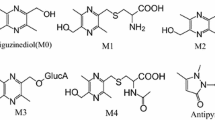Abstract
Multiple-species plasma-stability testing and pharmacokinetic studies in rats and dogs were performed on LK-157, a novel 10-ethylidene tricyclic carbapenem and potent inactivator of β-lactamases of classes A, C, and D. An LC–MS–MS method was developed and validated for analysis of LK-157 in rat and dog plasma. Separation was achieved on a C18 column by gradient elution. The lower limit of quantification for LK-157 in plasma was 50 ng mL−1. Intra-day and inter-day precision were <12.5 and <11.8%, respectively. When degradation of LK-157 was assessed in buffer solutions and in rat, dog, and human plasma, the compound was found to be stable in pH 7.0–9.0 phosphate buffer for 24 h at room temperature, and in human plasma for 60 min at 37 °C. The stability of LK-157 was species-dependent. Results from study of in vitro metabolism showed that the enzymes liver cytochrome P450 and uridine diphosphate glycosyltransferase do not metabolize LK-157. LC–MS–MS was also successfully applied to a pharmacokinetic study. The pharmacokinetics of LK-157 after bolus intravenous administration (10 mg kg−1) to Wistar rats and Beagle dogs was described by a two-compartment pharmacokinetic model. Human pharmacokinetic data were extrapolated from dog pharmacokinetic data. The extrapolated human terminal-phase half-life of LK-157 was 2.3 h. Stability and pharmacokinetic data for LK-157 are in agreement with results for other inactivators of β-lactamases.






Similar content being viewed by others
References
Livermore DM (1998) J Antimicrob Chemother 41(Suppl D):25–41. doi:10.1093/jac/41.suppl_4.25
Miller LA, Ratnam K, Payne DJ (2001) Curr Opin Pharmacol 1:451–458. doi:10.1016/j.jinf.2007.04.007
Kresken M, Brauers J, Preželj A (2007) Abstr F1-0338. In: Abstr 47th Intersci Conf Antimicrob Agents Chemother, Chicago, IL, 17–20 September 2007
Plantan I, Selič L, Mesar T, Anderluh PŠ, Oblak M, Preželj A, Hesse L, Andrejašič M, Vilar M, Turk D, Kocijan A, Prevec T, Vilfan G, Kocjan D, Čopar A, Urleb U, Šolmajer T (2007) J Med Chem 50(17):4113–4121. doi:10.1021/jm0703237
Preželj A, Plantan I, Vilfan G, Anderluh PŠ, Selič L, Igličar P, Car V, Oblak M, Šolmajer T, Andrejašič M, Turk D, Paukner S, Hesse L, Čopar A, Urleb U (2007) Abstr F1-316. In: Abstr 47th Intersci Conf Antimicrob Agents Chemother, Chicago, IL, 17–20 September 2007
Preželj A, Plantan I, Vilfan G, Anderluh PŠ, Selič L, Igličar P, Car V, Andrenšek S, Legen I, Smrdel P, Locatelli I, Mrhar A, Kovačić N, Černe M, Urleb U (2007) Abstr F1-317. In: Abstr 47th Intersci Conf Antimicrob Agents Chemother, Chicago, IL, 17–20 September 2007
Spangler SK, Jacobs MR, Appelbaum PC (1997) Antimicrob Agents Chemother 41(1):148–155
De Nardi C, Ferrari L, Nardin E, Ruffo A, Braggio S (2001) J Chromatogr B 752:133–139. doi:10.1016/S0378-4347(00)00533-8
De Nardi C, Braggio S, Ferrari L, Fontana S (2001) J Chromatogr B 762:193–201. doi:10.1016/S0378-4347(01)00362-0
Iavarone L, Bottacini M, Pugnaghi F, Morandini C, Grossi P (1997) Xenobiotica 27(7):693–709
Wise R, Andrews JM, Da Ros L, Child J, Mortiboy D (1997) Antimicrob Agents Chemother 41(8):1761–1764
Rovatti L, Garzotti M, Casazza A, Hamdan M (1998) J Chromatogr A 819:133–142. doi:10.1016/S0021-9673(98)00485-3
Wu Y (2000) Biomed Chromatogr 14(6):384–396. doi:10.1002/1099-0801(200010)14:6<384:AID-BMC30>3.0.CO;2-D
Iavarone L, Scandola M, Pugnaghi F, Grossi P (1995) J Pharm Biomed Anal 13:607–614. doi:10.1016/0731-7085(95)01290-2
Zhao ZZ, Qin X, Reed RA (2002) J Pharm Biomed Anal 29:173–181. doi:10.1016/S0731-7085(02)00008-0
Čopar A, Prevec T, Anžič B, Mesar T, Selič L, Vilar M, Šolmajer T (2002) Bioorg Med Chem Lett 12(6):971–975. doi:10.1016/S0960-894X(02)00061-6
http://www.fda.gov/downloads/Drugs/GuidanceComplianceRegulatoryInformation/Guidances/ucm070107.pdf
Shabir GA (2003) J Chromatogr A 987(1/2):57–66. doi:10.1016/S0021-9673(02)01536-4
Fang J, McKay G, Song J, Remillrd A, Li X, Midha K (2001) Drug Metab Dispos 29(12):1638–1643
Mahmood I (1999) J Pharm Pharmacol 51(8):905–910. doi:10.1211/0022357991773320
Travis CC, White RK, Ward RC (1990) J Theor Biol 142:285–304
Wildfeuer A, Räder K (1996) Int J Antimicrob Agents 6:S31–S34. doi:10.1016/S0924-8579(96)80005-7
Paukner S, Hesse L, Preželj A, Šolmajer T, Urleb U (2009) Antimicrob Agents Chemother 53(6):505–511. doi:10.1128/AAC.00085-08
Acknowledgments
The authors would like to acknowledge a group of chemists from Drug Discovery (Lek d.d., Ljubljana, Slovenia) for preparing the LK-157 used in these studies. In addition, we would like to thank Andrej Kocijan for his assistance with the TOF experiments.
Author information
Authors and Affiliations
Corresponding author
Rights and permissions
About this article
Cite this article
Igličar, P., Preželj, A., Locatelli, I. et al. Analysis of LK-157 in Plasma by LC–MS–MS: Application to Studies of Pharmacokinetics and Degradation Pathways in Rats and Dogs. Chroma 70, 1103–1112 (2009). https://doi.org/10.1365/s10337-009-1307-5
Received:
Revised:
Accepted:
Published:
Issue Date:
DOI: https://doi.org/10.1365/s10337-009-1307-5




